| Oracle® Fusion Middleware Administrator's Guide for Oracle Access Manager 11g Release 1 (11.1.1) Part Number E15478-02 |
|
|
View PDF |
| Oracle® Fusion Middleware Administrator's Guide for Oracle Access Manager 11g Release 1 (11.1.1) Part Number E15478-02 |
|
|
View PDF |
This chapter describes how to monitor OAM 11g performance using Oracle Fusion Middleware Control. This chapter focuses on general tasks that administrators can perform for Oracle Access Manager from Fusion Middleware Control. This information does not replace details in the Oracle Fusion Middleware Administrator's Guide.
This chapter includes the following topics:
Displaying OAM 11g Menus and Pages in Fusion Middleware Control
Displaying Farm Routing Topology in Fusion Middleware Control
Oracle Fusion Middleware Control must be deployed with Oracle Access Manager 11g on the WebLogic Administration Server, as described in the Oracle Fusion Middleware Installation Guide for Oracle Identity Management.
Within Fusion Middleware Control OAM information is updated dynamically during live sessions.
Fusion Middleware Control organizes a wide variety of performance data and administrative functions into distinct Web-based pages. This helps administrators easily locate the most important monitoring data and the most commonly used administrative functions from a Web browser.
Note:
Enterprise Manager Grid Control is an independently licensed product that provides additional capabilities not found in Fusion Middleware Control (primarily, the ability to collect and maintain data for historical purposes and trending).Oracle Access Manager 11g is deployed as a Java EE application in a WebLogic container. For high availability and failover, OAM is typically deployed in a WebLogic cluster environment. A WebLogic Server domain can have multiple clusters. To provide monitoring and performance statistics for all clustered components requires a composite target. This target provides status and rolled-up load and response performance metrics for member instances. In addition to the metrics exposed for OAM, generic performance metrics are also available for Java EE application and composite Java EE applications.
Fusion Middleware Control must be deployed with Oracle Access Manager 11g on the WebLogic Administration Server, as shown in Figure 16-1.
Using Fusion Middleware Control for OAM targets is supported through the Oracle Dynamic Monitoring Service instrumentation within OAM. This instrumentation is used to provide:
OAM performance overview and drill down
OAM log message searches and dynamic log level changes
OAM routing topology overview
OAM Mbean browser
This section provides the following topics:
The Fusion Middleware Control Login page provides the usual fields for the User Name and Password. The bottom of the Fusion Middleware Control Login page provides topics that you can click for additional information. The Login page is shown in Figure 16-2.
Only Fusion Middleware Control administrators can perform this task.
See Also:
Oracle Fusion Middleware Administrator's Guide for details about getting started using Fusion Middleware ControlTo log in to Fusion Middleware Control
In a browser window, enter the URL to Fusion Middleware Control. For example:
http://host.domain.com:8888/em/
Expand a topic at the bottom of the Login page to learn about the enhanced user experience or new features.
Log in as a Fusion Middleware Control administrator.
Choose the farm containing OAM 11g, if needed.
Help: From the Farm Resource Center on the OAM Farm page, choose topics of interest (or click Help in the upper-right corner of the page) to get more information.
Proceed to any topic in this chapter for viewing and configuration details.
This section provides the following topics:
See Also:
Oracle Fusion Middleware Administrator's Guide for details about getting started using Fusion Middleware ControlFigure 16-3 illustrates the OAM Farm page in Fusion Middleware Control. Each Farm page includes similar information. The Farm Resource Center provides immediate access to online information.
Sections on the Farm page are described in Table 16-1.
Table 16-1 Farm Page Sections
| Farm Page Sections | Description |
|---|---|
|
Deployments |
Within the farm, this section displays the Status and Target of each Internal Application within the Application Deployment. Clicking any link in the Deployments section (or in the navigation tree) displays a page containing more information. |
|
Fusion Middleware |
Within the farm, this section displays the status, host, and CPU usage for server instances in the:
Clicking any link on the page (or in the navigation tree) displays a page containing a more detailed summary. |
|
Farm Resource Center |
Provides a wealth of online information in the following categories:
Clicking any link in the resource center displays information on the chosen subject. With a wealth of information online, these details are not repeated in this book. |
The navigation tree on the left side of the page, like the one in Figure 16-4, enables you to choose a specific instance (target) on which to operate regardless of the page you are currently viewing. Target names in your environment will be different.
For more information, see "Logging In To Fusion Middleware Control".
OAM Farm details in Fusion Middleware Control are divided into the following nodes within the navigation tree:
Application Deployments
Internal Applications (includes logout page and other details for the OAM AdminServer and OAM Server instances)
WebLogic Server domains (WebLogic Server details, including the OAM Farm)
Identity and Access (includes OAM Cluster or individual OAM Server instances)
Clicking a node in the navigation tree displays an information page with individual links and a description of the Target, Type, and Full Name, as shown in Figure 16-5 for Application Deployments.
Clicking an instance (target) name (from either the navigation tree or a page), displays a context menu and a more detailed summary page, as shown in Figure 16-6. Notice that the Internal Application target is highlighted in the navigation tree and a page of the same name is displayed on the right. The context menu is available beneath the target name at the top of the page.
The Application Deployment menu is shown in Figure 16-7.
WebLogic Server domain: The WebLogic Server domain page is shown in Figure 16-7 with the corresponding menu displayed. The Oracle WebLogic Server domain Resource Center, with links to online documentation, is visible in the bottom-left corner. This page more closely resembles the Farm landing page.
Selecting a target name within the WebLogic Server domain node displays a target summary page that more closely resembles the Application Deployment page in Figure 16-5.
For more information, see "Displaying Context Menus and Target Details in Fusion Middleware Control".
See Also:
"Viewing OAM Performance in Fusion Middleware Control" for information about the Identity and Access node and related pages.Fusion Middleware Control administrators can use the following procedure to view context menus and target pages.
Note:
From the Farm Resource Center on the OAM Farm page, choose topics of interest (or click Help in the upper-right corner of the page) to get more information.To display context menus and target information
Log in as described in "Logging In To Fusion Middleware Control".
Expand the Farm containing OAM 11g, if needed.
Information Pages: From the navigation tree, click one of the following to display the related information page:
Application Deployments
WebLogic Server domain
Identity and Access
Menus and Summary Pages: Click an instance name (in either the navigation tree or the related page) to display a summary page and menu (Figure 16-6 and Figure 16-7).
OAM Cluster or OAM Server Pages: See "Viewing OAM Performance in Fusion Middleware Control".
Fusion Middleware Control provides administrators with:
A cluster-wide view of OAM performance
A per-server drill-down of key performance metrics
The ability to quickly add or remove performance metrics
Using Fusion Middleware Control, you can view performance metrics for live OAM 11g sessions in a variety of formats. Table 16-2 summarizes the pages for selected nodes and target instances.
Table 16-2 Resulting Pages for Selected Nodes and Targets
| Node | Target | Information Summary Page | Performance Overview | Performance Summary w/Metrics |
|---|---|---|---|---|
|
Application Deployment Internal Applications |
...AdminServer oamsso_logout(11.1.1.3.0) AdminServer oamsso_logout(11.1.1.3.0) oam_server |
Yes Yes Yes |
No No No |
Yes Yes Yes |
|
WebLogic Server domain |
oam_bd (Cluster name) AdminServer oam_server |
Yes Yes Yes |
No No No |
No Yes Yes |
|
Identity and Access |
OAM (Oracle Access Manager Cluster) oam_server (Oracle Access Manager Server) |
No No |
Yes Yes |
Yes Yes |
This section provides the following topics:
About OAM Performance Overview Pages in Fusion Middleware Control
Configuring OAM Performance Metrics in Fusion Middleware Control
The Fusion Middleware Control Performance Overview for OAM can be used to reflect WebLogic cluster information down to specific performance metrics for individual OAM Cluster and OAM Server targets.
Oracle Access Manager Cluster Pages: The top node within Identity and Access leads to a page for the OAM Cluster Deployment, which includes a Performance Overview. In Figure 16-9, notice the Oracle Access Manager Cluster selected in the navigation tree, beneath the Identity and Access node. Figure 16-9 illustrates the Oracle Access Manager Cluster Performance Overview and Deployments section.
OAM Server Pages: Selecting an OAM target name from the navigation tree (or the open page), displays a Performance Overview for the target with a summary of Key Metrics at the top (replacing the Deployment section, which appears on the Cluster page).
Table 16-3 describes the elements of the Performance Overview for OAM Clusters and OAM Server instances in Fusion Middleware Control. There are only a few differences.
Table 16-3 Summary of OAM Performance Overviews in Fusion Middleware Control
| Element | Description |
|---|---|
|
Deployments |
This section appears only on OAM Cluster pages to describe the status of instances in the overview. |
|
Instance Name |
The name of the OAM Server to which the metrics apply. For example: OAM_server_name |
|
Status |
The status of the OAM Server instance, illustrated with one of the following:
|
|
Authentications/sec |
The number of authentications per second. |
|
Success Rate (% of Authentications Successful) |
A numeric value representing the percentage of successful authentications. |
|
Authorizations/sec |
The number of authorizations per second. |
|
Success Rate (% of Authorizations Successful) |
A numeric value representing the percentage of successful authorizations. |
|
Key Metrics |
Summary of statistics displayed only for the selected OAM Server instance.  |
|
Oracle Access Manager Menus |
Dynamic context menus provide functions related to the selected target (also available when you right-click a target in the navigation tree). The Oracle Access Manager Cluster menu is shown here: 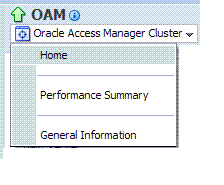
The OAM Server menu is shown next. 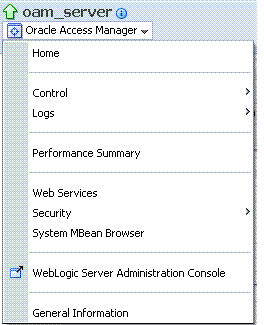 |
|
Performance Overview |
This section provides a graphic representations of authentication and authorization. The date is identified beneath the tables, which include information on:
Within each table:
Note: The metrics on the Performance Overview are not configurable. The Metrics Palette is available for only the Performance Summary. |
|
Table View |
Click this item on the right side of the page to display the Performance Overview in tabular format within a pop up window. |
|
LDAP Servers |
This section is available only when the OAM Cluster is selected to provide information for the primary LDAP user identity store:
|
|
Access Clients |
This section of the page provides information for all active Access Clients. |
|
Client ID |
Displays the name of the Agent, as defined in the Agent registration in the OAM Administration Console. For example: Agent_test |
|
Type |
Displays the Agent. type For example: OAM WebGate |
|
Authentications/sec |
Displays the number of authentications per second processed by this Agent. |
|
Authentications Latency (ms) |
Displays the number of milliseconds the authentication was delayed. |
|
Success/Fail Ratio (%) |
Displays a numeric value representing the percentage of successful authentications as compared to failed authentications. |
|
Authorizations/sec |
Displays the number of authorizations per second processed by this Agent. |
|
Authorizations Latency (ms) |
Displays the number of milliseconds the authorization was delayed. |
|
Success/Fail Ratio (%) |
Displays a numeric value representing the percentage of successful authorizations as compared to failed authorizations. |
|
Application Domains |
This section of the page provides information for all Application Domains that were used during authentication and authorization processing. |
|
Application Domain Name |
Displays the name of the application domain that contains the authentication and authorization policies used for the request. |
|
Authentications/sec |
Within the named application domain, the number of authentications per second processed by this Agent. |
|
Authentications Latency (ms) |
Within the named application domain, the number of milliseconds the authentication was delayed. |
|
Success/Fail Ratio (%) |
Within the named application domain, the numeric value representing the percentage of successful authentications as compared to failed authentications. |
|
Authorizations/sec |
Within the named application domain, the number of authorizations per second processed by this Agent. |
|
Authorizations Latency (ms) |
Within the named application domain, the number of milliseconds the authorization was delayed. |
|
Success/Fail Ratio (%) |
Within the named application domain, the numeric value representing the percentage of successful authorizations as compared to failed authorizations. |
|
Authentications/sec |
Within the named application domain, the number of authentications per second processed by this Agent. |
|
Authorizations/sec |
Within the named application domain, the number of authorizations per second processed by this Agent. |
The Performance Summary command on the Oracle Access Manager Cluster or OAM Server menu displays metrics charts for the selected target. On the Performance Summary page, a chart is displayed for each selected metric.
An OAM Server Performance Summary page is shown in Figure 16-10 with an open Metric Palette from which you can choose the exact metrics you want to chart. Stacked charts allow you to easily compare multiple metrics for the same time frame, change the time frame to go back in time, or zoom in or out.
Table 16-4 describes the status and controls available on the Performance Summary page.
Table 16-4 Status and Controls on Performance Summary Pages
| Status or Control | Description |
|---|---|
|
Past n minutes |
Status is based on the specified time period, which can be adjusted using the slider. |
|
All |
|
|
n Minutes |
The specified time period, which can be adjusted using the slider. |
|
Slider |
The tool you use to adjust the time period.  |
|
Chart Set |
A list from which you can choose the set of saved charts to view. |
|
View |
A menu that enables you to add a grid, save a chart, and order information on the page. 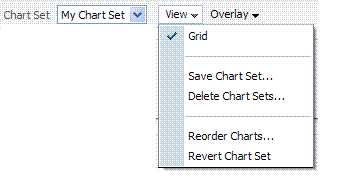 |
|
Overlay |
A menu that enables you to search for and view another instance of the same type and compare this against the instance in the summary.  |
|
Metric Palette |
A listing from which you can select performance metrics to chart. Items unique to Oracle Access Manager 11 are shown here. 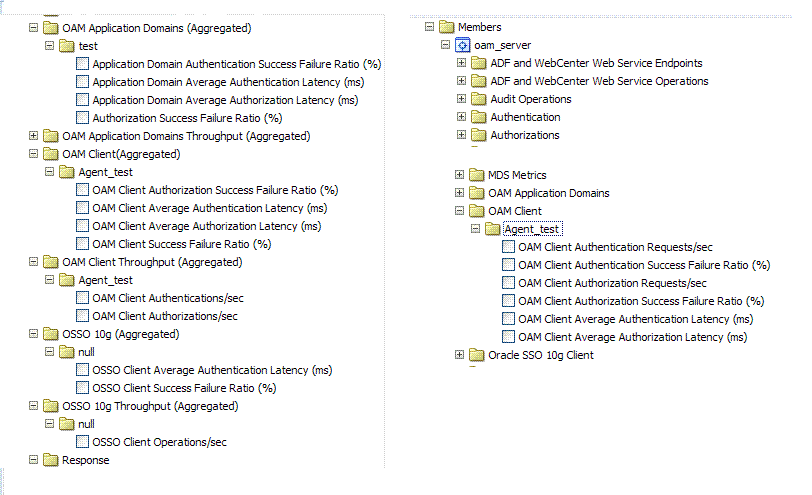 |
Fusion Middleware Control administrators can use the following procedure to add or change the metrics that are displayed in the OAM Performance Summary.
See Also:
To add or change metrics in the Performance Summary
Log in as described in "Logging In To Fusion Middleware Control".
Expand the desired node and select a target. For example:
From the OAM context menu, select Performance Summary.
From the Performance Summary page, click Show Metrics Palette.
From the Metrics Palette, expand nodes and check (or clear) boxes to add (or remove) metrics from the summary.
Review the updated the Summary page.
Click Hide Metrics Palette when you finish.
Saving a Chart Set:
From the View menu on the Performance Summary page, click Save Chart Set.
In the dialog box that appears, enter a unique name for this chart set and click OK when the operation is confirmed.
Proceed to "Viewing OAM Performance in Fusion Middleware Control".
Fusion Middleware Control administrators can use the following procedure to view and compare OAM performance data for either the entire OAM Cluster or a single OAM Server instance.
See Also:
To view OAM performance
Log in as described in "Logging In To Fusion Middleware Control".
Performance Overview:
Expand the desired node and select a target. For example: Identity and Access.
Review the Performance Overview.
Notice the target menu.
Performance Summary: From the context menu (Step 2), select Performance Summary. Otherwise,
Expand the desired node and select a target. For example: Identity and Access.
From the context menu, select Performance Summary.
Review the Summary Page.
Changing Metrics: See "Configuring OAM Performance Metrics in Fusion Middleware Control".
Saving a Chart Set:
From the View menu on the Performance Summary page, click Save Chart Set.
In the dialog box that appears, enter a unique name for this chart set and click OK when the operation is confirmed.
Click Hide Metrics Palette when you finish.
Review the updated information on the Summary Page.
Adding an Overlay:
From the Overlay menu on the Performance Summary page, click Another Oracle Access Manager.
In the Search and Select Targets dialog, enter the target name and host name, then click Go.
In the target results table, click the name of the desired target and then click Select.
When finished viewing the overlay, click Remove Overlay from the Overlay menu.
Testing:
Using the Access Tester, perform several authentication and authorization tests (see Chapter 10).
In Fusion Middleware Control, check performance metrics.
Oracle Fusion Middleware components generate log files containing messages that record all types of events. Administrators can set log levels using Fusion Middleware Control, as described in this chapter.
Note:
Alternatively, administrators can set OAM logger levels using custom WebLogic Scripting Tool (WLST) commands, as described in Chapter 13.Topics in this section include:
Using Fusion Middleware Control, administrators can change OAM 11g log levels dynamically.
Table 16-5 outlines OAM 11g log availability and functions in Fusion Middleware Control
Table 16-5 OAM Log Availability and Functions in Fusion Middleware Control
| Node | Target | View Log Messages | Log Configuration |
|---|---|---|---|
|
Application Deployment Internal Applications |
...AdminServer oamsso_logout(11.1.1.3.0) AdminServer oamsso_logout(11.1.1.3.0) oam_server |
Yes Yes Yes |
Yes Yes Yes |
|
WebLogic Server domain |
oam_bd (Cluster name) AdminServer oam_server |
Yes Yes Yes |
No Yes Yes |
|
Identity and Access |
OAM (Oracle Access Manager Cluster) oam_server (Oracle Access Manager Server) |
No Yes |
No Yes |
Figure 16-11 shows the Log Levels configuration page Fusion Middleware Control.
The Log Levels tab on the Log Configuration page allows you to configure the log level for both persistent loggers and active runtime loggers:
Persistent loggers are saved in a configuration file and become active when the component is started.
The log levels for these loggers are persisted across component restarts.
Runtime loggers are automatically created during runtime and become active when a particular feature area is exercised.
For example, oracle.j2ee.ejb.deployment.Logger is a runtime logger that becomes active when an EJB module is deployed. Log levels for runtime loggers are not persisted across component restarts.
Table 16-6 explains the configuration status and options for log levels.
Table 16-6 Log Levels Tab on Log Configuration Page
| Element | Description |
|---|---|
|
Apply |
Submits and applies log level configuration changes, which take affect immediately. |
|
Revert |
Restores the target's previous log level configuration, which take affect immediately. |
|
View |
Use this list to view runtime loggers or loggers with a persistent log level state.
|
|
Search |
Use this list to specify the categories you would like to search. 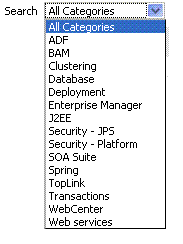 |
|
Table |
|
|
Logger Name |
The name of the loggers found during the search. You can expand names in the list to see any loggers beneath the top node. 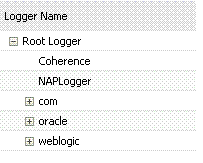 |
|
Oracle Diagnostic Logging Level (Java Level) |
Choose the logging level for the corresponding logger; c. 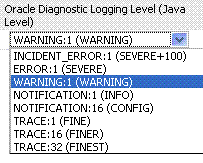
Click Apply and review confirmation messages displayed in a pop-up window: Updating log levels Updating the log levels of runtime loggers The log levels of runtime loggers have been updated successfully The log levels have been updated successfully |
|
Log File |
Clicking a name in the Log File column displays the Log Files page, which you can use to create and edit the file where log messages are logged, the format of the log messages, rotation policies, and other logging parameters. See Also: "Managing OAM Log File Configuration from Fusion Middleware Control". |
|
Persistent Log Level State |
Identifies the persistent state for this specific logger, which is set when you create or edit the value using the Log Files tab. |
Fusion Middleware Control administrators can use the following procedure to set the log level for OAM 11g components dynamically.
See Also:
"About Dynamic Log Level Changes"Note:
Alternatively, administrators can set OAM logger levels using custom WebLogic Scripting Tool (WLST) commands, as described in Chapter 13.To configure logging levels dynamically in Fusion Middleware Control
Log in as described in "Logging In To Fusion Middleware Control".
Expand the desired node, and select a target. For example: Identity and Access.
From the OAM context menu, select Logs and then choose Log Configuration.
Click the Log Levels tab, if needed, to display the configuration page (Table 16-6).
From the View list, choose the loggers to display. For example: Runtime Loggers.
From the Search list, choose the desired category.
In the table, expand nodes to reveal information as needed.
In the table, choose new log levels, as needed, and then click Apply (or Revert).
Proceed to "Managing OAM Log File Configuration from Fusion Middleware Control"
This section provides the following information:
Figure 16-11 shows the Log Files Configuration. Use this page to create and edit where the log messages will be logged to, the format of the log messages, the rotation policies used, as well as other parameters depending on the log file configuration class.
Table 16-7 describes the OAM log files configuration parameters.
Table 16-7 Log Files Elements
| Element | Description |
|---|---|
|
Create |
Click this button to display the fresh form to create a new file for logged messages. Notes:
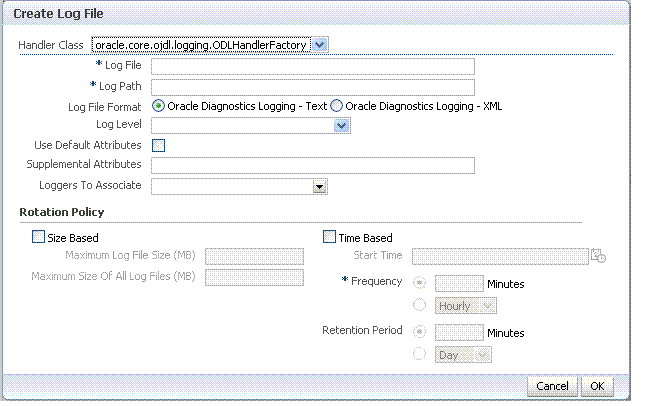 |
|
Create Like |
Click this button to display a partially filled-in form to create a new file for logged messages. 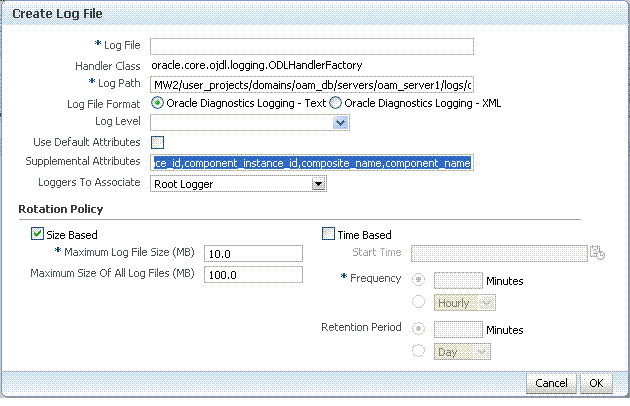 |
|
Edit Configuration |
Click this button to display and edit the selected log file configuration. |
|
View Configuration |
Click this button to view a read-only description of the selected log file configuration. |
|
Table |
The information in this table is based on log file configuration parameters in this table. |
|
Handler Name |
The Log File name assigned during log file creation. |
|
Log Path |
The file system directory path assigned during log file creation. |
|
Log File Format |
The Log File format assigned during log file creation. |
|
Rotation Policy |
The rotation policy selected during log file creation. |
Fusion Middleware Control administrators can use the following procedure to create an OAM log file, edit the configuration, or view a read-only version of the log file configuration.
See Also:
"About Log File Configuration"To configure logging for OAM in Fusion Middleware Control
Log in as described in "Logging In To Fusion Middleware Control".
Expand the desired node, and select a target. For example: Identity and Access.
From the OAM context menu, select Logs and then choose Log Configuration.
Click the Log Files tab if needed to display the configuration page (Table 16-7).
Create a Log File:
Click the Create button to display a fresh Create Log File form.
Enter a name and file system path for this log file. For example:
Log File oam-odl-handler
Log Path domains/oam_db/servers/oam-server1/log/oam.log
Click the desired Log File Format. For example: ... Text
Set the logging attributes. For example:
Use Default Attributes X
Supplemental Attributes
Associate a Logger. For example: Root Logger
Specify the Rotation Policy. For example: Size Based
Maximum Log File Size (MB) 10.0
Maximum Size of All Log File Size (MB) 1000.0
Click OK to submit the configuration.
Create Like:
From the Log Files tab, click the name of an existing log file.
Click the Create Like button.
On the Create Log File form, enter a new:
Log File name
Log Level
Attributes
Edit any other details as needed, then click OK to submit the configuration.
Edit Configuration:
From the Log Files tab, click the name of an existing log file configuration.
Click the Edit Configuration button.
Change configuration details as needed.
Click OK to submit the configuration.
View Configuration:
From the Log Files tab, click the name of an existing log file configuration.
Click the View Configuration button.
Review the information, then click OK to dismiss the configuration page.
Proceed to "Locating and Viewing OAM Log Messages in Fusion Middleware Control".
This section includes the following topics:
By using context menus in Fusion Middleware Control, administrators can locate, view, and export key log information for:
Application Deployment targets, including the WebLogic (and OAM) AdminServer and the OAM SSO logout pages on both AdminServer and OAM Servers
WebLogic Server domain targets, including the OAM Farm, AdminServer, and OAM Servers
Identity and Access targets, including the OAM Farm and OAM Servers
Using log files to troubleshoot common problems requires that you:
Get familiar with the Oracle Diagnostic Logging (ODL) format used by Oracle Fusion Middleware components, as described in the Oracle Fusion Middleware Application Security Guide
Configure log files to collect the appropriate level of information
Search, view and export key log information in the farm
Correlate messages in log files across components
Figure 16-13 shows the OAM 11g Log Messages page in Fusion Middleware Control.
Table 16-8 describes elements on the Log Messages page in Fusion Middleware Control.
Table 16-8 OAM Log Message Search Controls in Fusion Middleware Control
| Element | Description |
|---|---|
|
Broaden Target Scope |
Select items on this list to expand (or narrow) the targets that are used in this search:
|
|
Target Log Files... |
Displays a list of all log files for the target scope from which you can select a specific log file to view or download. |
|
Refresh Options |
Select an item from this list to specify the refresh method:
|
|
Search Options |
|
|
Date Range |
The period during which the desired set of messages was logged:
|
|
Message Types |
Check all message types that apply for this search:
|
|
Message |
Choose an identifier from this list and add a value in the blank field beside it to refine your search criteria: 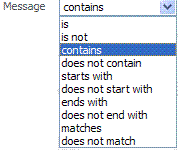 |
|
Add Fields |
Click this button to display a list of additional search criteria you can include. 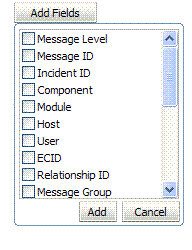 |
|
Search |
Click this button to initiate a search using the specified criteria. |
|
Viewing Options |
|
|
View |
Choose items from this menu to view or reorder columns in the search results table: 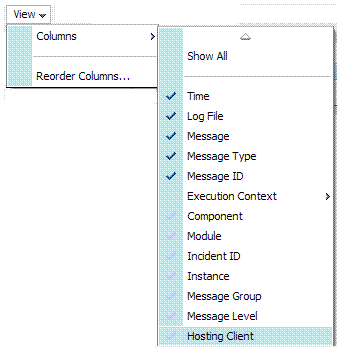 |
|
Show |
Select the entity to view:  |
|
View Related Messages |
This menu is available when at least one message is listed in the search results.  |
|
Export Messages to a File |
A menu of viewing commands that are available when at least one message is listed in the search results. You can choose from the following commands:  |
|
Results Table Columns |
These are based on selections in the View menu on the Log Messages page.  |
|
Message Area |
Displays details for the selected message in the search results table.  |
Fusion Middleware Control administrators can use the following procedure to view and download log messages for the target. This procedure explains how to search for messages, view messages (or view related messages), view all messages in a single log file, and export or download messages.
To view OAM Server log messages within Fusion Middleware Control
Log in as described in "Logging In To Fusion Middleware Control".
Expand the desired node and select a target. For example: Identity and Access.
From the OAM context menu, select Logs and then choose View Log Messages.
Search (Table 16-8):
Specify the Date Range.
Check all Message Types to be included in your search.
Define Message content options.
Add Fields: Enter details to further refine message content.
Click Search to display a list of messages that fit your search criteria.
View Messages: Click one or more messages to view from the table of search results to review messages.
View Related: Use one of the following methods to organize the table of search results.
By Time: From the View Related menu, select by Time.
By ECID: Click ECID in the message on the screen (or, from the View Related menu, select by ECID Execution Context ID).
From the Scope menu, select a time period.
Log File: From the table of search results, click the name in the Log File column to view all messages in the file.
Export Messages
Select one or more messages in the search results table.
From the Export Messages menu, choose the desired export format. For example: As Oracle Diagnostic Log (.txt).
In the dialog box, click Open with and then choose the desired program.
From the open program, save the file to a new path.
Download
Select one or more messages in the search results table.
Click the Download button.
In the dialog box, click Open with and then choose the desired program.
From the open program, save the file to a new path.
Testing:
Using the Access Tester, enter an invalid user name and try to authenticate (see Chapter 10).
In Fusion Middleware Control, go to the log viewer and review the error.
Using the Access Tester, enter an invalid password and try to authenticate.
In the Fusion Middleware Control log viewer, check the error and then view all related log messages.
Repeat this test using different log levels, as described in "Managing Log Level Changes in Fusion Middleware Control".
A Java object is a unit of code that runs the computer. Each object is an instance of a particular class or subclass that rely on the class's methods or procedures or data variables. Within the Java programming language, a Java object that represents a manageable resource (application, service, component, or device) is known as an MBean (managed bean).
Fusion Middleware Control enables you to:
View information on key MBean Attributes and Operations
Invoke methods
This section provides the following topics:
The Fusion Middleware Control System Mbean Browser can be used to view the items outlined in Table 16-9.
Table 16-9 System MBean Browser
| Node | Target | System Mbean Browser |
|---|---|---|
|
Application Deployment Internal Applications |
...AdminServer oamsso_logout(11.1.1.3.0) AdminServer oamsso_logout(11.1.1.3.0) oam_server |
Yes Yes Yes |
|
WebLogic Server domain |
oam_bd (Cluster name) AdminServer oam_server |
Yes Yes Yes |
|
Identity and Access |
OAM (Oracle Access Manager Cluster) oam_server (Oracle Access Manager Server) |
No Yes |
Figure 16-14 Shows the System MBean Browser page.
Table 16-10 describes the System MBean Browser and associated tabs.
Table 16-10 System MBean Browser
| System MBean Browser | |
|---|---|
|
System MBean Browser |
Expand items in this section to display Mbeans for the selected target. 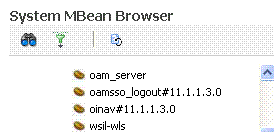 |
|
MBean Information |
Details for Attributes and Operations related to the MBean for the selected target are displayed on the right.  |
|
Attributes |
This tab describes MBean attributes for the selected target.  |
|
Operations |
This tab describes MBean operations for the selected target.  |
|
Notifications |
This tab lists any notifications resulting from the invocation of an MBean. |
|
Name |
Clicking a name on either tab displays a full description of related MBeans. |
|
Apply |
Submits and applies the selected MBean attribute value. |
|
Revert |
Restores previous MBean attribute values following a change (and before clicking Apply). |
|
Return |
Returns you to the MBean Information page. |
|
Invoke |
Invokes the selected MBean and value. |
Fusion Middleware Control administrators can use the following procedure to view OAM 11g MBeans. Additionally, you can apply values (or revert the change) and invoke OAM 11g MBeans.
To view, edit, or invoke OAM 11g MBeans
Log in as described in "Logging In To Fusion Middleware Control".
Expand the desired node and select a target. For example:
From the OAM context menu, select System MBean Browser.
System MBean Browser: Expand classes and select a target to display related attributes and operations.
Manage MBean Attributes:
Click the Attributes tab.
Review the name and description of MBean attributes for the selected target.
Edit values for one or more attributes and click Apply to submit changes (or click Revert to cancel changes).
Alternatively: Click a Name in the Attributes table to display a full description and the value; change the value and click Apply (or click Revert to cancel the change).
Manage MBean Operations:
Click the Operations tab.
Review the name, description, number of parameters, and the return type for each MBean operation for the selected target
Click a name in the Operations table to display the parameters and related name, description, type, and value.
Edit values for the operation and click Apply to submit changes (or click Revert to cancel changes).
Click Invoke to invoke the MBean and review the message that appears. <<<then what?>>>
Fusion Middleware Control enables you to view a graphical representation of the Oracle Access Manager routing topology.
This section provides the following topics:
Figure 16-15 shows the Farm routing topology page in Fusion Middleware Control.
Table 16-11 describes the status and controls on the Farm topology page.
Table 16-11 Farm Topology
| Element | Description |
|---|---|
|
Save Image |
Saves the image. |
|
|
Prints the image. |
 |
Scales the image. |
|
Find |
Enter a value or simply click Find to display results. 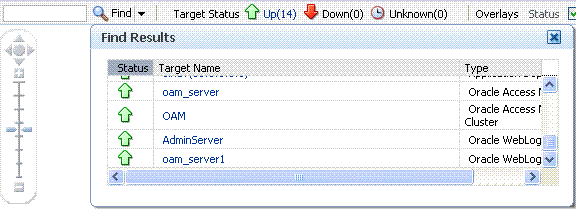 |
|
+ |
Expands the instance on the topographical view to provide more information. 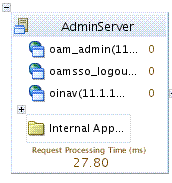 |
|
Status Bar |
Displays the full farm name and targets within the farm., as well as the up and down status. You can choose to overlay the status and metrics on individual instances in the topology view.  |
Fusion Middleware Control Administrators can use the following procedure to view the routing topology of the farm that includes OAM 11g.
See Also:
"About the Routing Topology"To view Farm routing topology
Log in as described in "Logging In To Fusion Middleware Control".
Select the Farm in the navigation tree.
Click Topology above the navigation tree.
In the Topology Browser window, click the name of the farm and click OK.
Use the scaling tool to shrink or grow the image.
Expand instances in the topology to display details about each one.
Use the Overlay options to add status and metrics information to the instances.
Use the Find option to locate specific information (Table 16-11).
Click Print or Save, as needed.